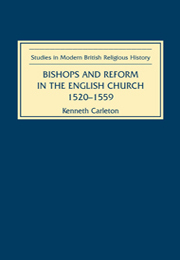Book contents
- Frontmatter
- Contents
- List of Illustrations
- Dedication
- List of Abbreviations
- Acknowledgements
- Introduction
- 1 Theologies of Episcopacy in mid-Tudor England
- 2 Models of Episcopal Office
- 3 Bishops of the English Church, 1520–1559
- 4 The Bishop and Preaching
- 5 Bishops and the Provision of Education
- 6 Prayer and Sacrifice: the Life of the Bishop
- 7 Episcopal Activity I: the Eradication of Heresy
- 8 Episcopal Activity II: the Propagation of the Ministry
- 9 Conclusion: the Old Episcopate in a New Order
- Appendix I Prosopography of the bishops in office, 1520–1559
- Appendix II The dioceses
- Appendix III The education of the bishops
- Appendix IV The bishops of Sodor and Man
- Bibliography
- Index of Scriptural References
- General Index
Appendix IV - The bishops of Sodor and Man
Published online by Cambridge University Press: 12 September 2012
- Frontmatter
- Contents
- List of Illustrations
- Dedication
- List of Abbreviations
- Acknowledgements
- Introduction
- 1 Theologies of Episcopacy in mid-Tudor England
- 2 Models of Episcopal Office
- 3 Bishops of the English Church, 1520–1559
- 4 The Bishop and Preaching
- 5 Bishops and the Provision of Education
- 6 Prayer and Sacrifice: the Life of the Bishop
- 7 Episcopal Activity I: the Eradication of Heresy
- 8 Episcopal Activity II: the Propagation of the Ministry
- 9 Conclusion: the Old Episcopate in a New Order
- Appendix I Prosopography of the bishops in office, 1520–1559
- Appendix II The dioceses
- Appendix III The education of the bishops
- Appendix IV The bishops of Sodor and Man
- Bibliography
- Index of Scriptural References
- General Index
Summary
The see of Man was probably united with that of Sodor, or the South Hebrides, about 1098; at the time, both were part of the province of York. In 1154, Sodor and Man was placed under the charge of the Archbishop of Trondhiem. During the Great Schism, the original diocese of The Isles was split into a separate English succession in the Isle of Man (which was politically under English Lordship) and a Scottish line of bishops, which continued to administer the northern part of the diocese. The see was returned to the province of York in 1458 by a bull of Pope Callistus III. The cathedral was on St Patrick's Island off the Manx coast; it was dedicated to St Germanus and had a secular chapter. In 1517 the diocese had only one archdeaconry and seventeen parishes. Under an Act of 1542 (33 Henry VIII c.31) the English diocese of Sodor and Man was formally established alongside the old Scottish diocese of Sodor or The Isles, and placed in the province of York.
The bishops of Sodor and Man, like suffragan bishops, were not members of the House of Lords; all other diocesan bishops were automatically members by virtue of the temporal baronetcies annexed to their sees. Furthermore, few records survive for the diocese, and no episcopal registers exist for the period up to the dissolution of episcopacy. Further, where bishops of Sodor and Man do appear in the records, they tended to act in exactly the same way, and in the same situations, as bishops suffragan proper.
- Type
- Chapter
- Information
- Bishops and Reform in the English Church, 1520–1559 , pp. 207 - 208Publisher: Boydell & BrewerPrint publication year: 2001



